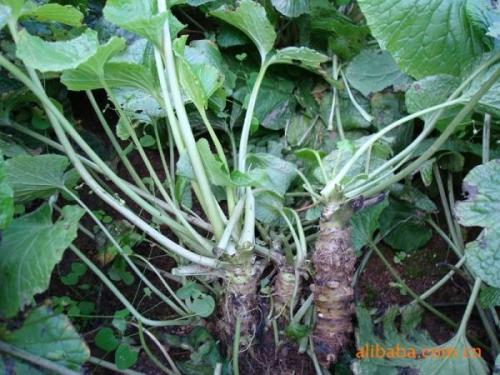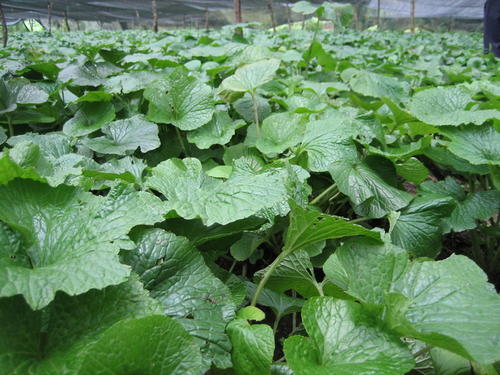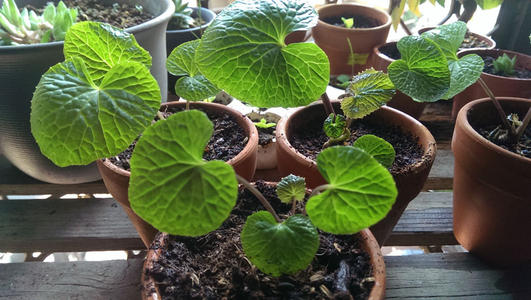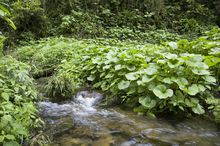Wasabi profile
Written by Maggie
May 12 2021

Wasabi (Wasabia japonica) is a kind of special edible health plant discovered in the world today. It is a very precious seasoning food in the international market, with high price and great market demand. Due to the special growing conditions of Wasabi and the limited places suitable for growing and planting, Wasabi products are extremely scarce in the international market. Wasabi not only has good taste and rich nutrition, but also has immunomodulatory effect and a variety of pharmacological effects such as antibacterial, anti-cancer and anti-oxidation.
Wasabi picture

Wasabi info
| Botanical Name | Wasabia japonica |
| Common Name | Wasabi, Japanese horseradish |
| Plant Type | Perennial |
| Mature Size | 24 inches tall |
| Sun Exposure | Full shade |
| Flower Color | White |
| Hardiness Zones | USDA 8a to 10b |
| Native Areas | Japan |
Wasabi morphological characteristics
The leaves of Wasabi are clustered, round and heart-shaped, and the leaf margin is undulate and serrated.Petiole about 30cm ~ 35cm long. The underground stem fertilizer is conical in shape, 5cm ~ 25cm in length and 2cm ~ 4cm in diameter. It is light green with acrimonial taste, and the taste is stronger after grinding.Roots are fibrous roots, which distribute horizontally in the soil of 10cm ~ 20cm. Racemose, terminal or axillary, white petals, long hornlike fruit, flowering in March to April, seeds can be harvested in May to June, seeds green like radish seeds. Wasabi takes 1.5 ~ 2 years from planting to rhizome harvesting, with rhizome yield of 320kg ~ 380kg per mu.
The origin of Wasabi
Wasabi distributes in mainland China, Taiwan, Japan.
How to grow and care for Wasabi
Light
Direct daylight is no longer tolerated properly by way of wasabi, so make certain the flowers are shaded. If you have to cross your containers out of the solar you can do so, however it is lots less difficult to create a coloration barrier with cloth (shade cloth) or a folding screen. Alternatively, you can pass the vegetation close to a safe haven the place the solar may not hit them.
Soil
If developing in containers, use a one or two-gallon pot with a ten-inch planting depth. Mix up some wealthy soil with compost; barely heavier than potting combine medium, so it will preserve moisture. Plant your begins so that they stand upright, leaving section of the rhizome exposed.
Water
Water your wasabi properly at planting and then in many instances after this. Misting the vegetation will additionally assist hold them cool. Take care now not to overwater as these flora do not tolerate waterlogged conditions.
Temperature and humidity
One necessary consideration for developing wasabi is that it tolerates solely a slim temperature range, preferring consistent temperatures of 50-60 stages Fahrenheit.
Temperatures beneath freezing (32F) or above 80F can kill the plant, so these extremes ought to be avoided. Some coastal areas like the Pacific Northwest grant suitably cool, temperate climate for developing wasabi. Planting in containers capacity you can go the flowers if the thermometer unexpectedly receives too excessive or too low.
If the leaves get droopy or wilted, pass the flowers to coloration and mist them a bit.
Pruning
Removing any wilted leaves that do not perk up after misting is recommended. This can assist to keep away from any unfold of disorder or powdery mildew.

Propagating Wasabi
Finding wasabi seeds may additionally show almost impossible, as they are now not effortless to germinate. Most growers buy "starts" from a legit dealer and plant them.
Wasabi common pests/diseases
There are a few pests that might also consume your wasabi. It's in the Brassica household and so any bugs that love to devour cabbage or broccoli, such as cabbage worms, will additionally revel in munching on wasabi.
Remove slugs through hand, and aphids can be eliminated with a regular circulation of water or a gentle cloth. Make positive cool temperatures and shady stipulations are maintained as this will assist deter pests.
Insecticidal soaps are now not endorsed for wasabi. If any fungal ailment is present, copper spray or baking soda spray can be used.
Harvesting Wasabi
You may not be in a position to harvest the rhizomes of your wasabi flowers until the 2nd year, so it is necessary to care for them attentively. The plant life will be mature ample for pulling inside fifteen months to two years. However, the vegetation will commence producing leaves inside about eight weeks, so you can revel in the bounty of your plant life whilst you wait for the mature stalks. It's exact to harvest these leaves to preserve the vegetation neat and healthy.
After your first harvest, let the plant develop extra leaves and harvest them each 6-8 weeks. If you cannot consume them all, or provide them to friends, the leaves can be blanched and frozen like any greens, or you can make a pesto-like sauce for pasta and rice and freeze it.
The stems can additionally be frozen, however are high-quality eaten fresh. They're crunchy and make a desirable addition to stir-fry dishes or salads.

Latest Updated
- Benefits of Bugleweed - 7 Science-backed Health Benefits
- Bugleweed Dangers & Side Effects - Is It Poisonous?
- How to Plant Evergreen Trees - What You Should Know
- When to Plant Evergreens - Grow Guide for Evergreen Trees
- 12 Wonderful Evergreen Shrubs for Your Garden
- 12 Popular Evergreen Plants with Pictures for Beginners
- When And How To Prune A Lilac Bush Like a Pro
- How to Grow & Care for Lilac Vine (Hardenbergia Violacea)
- Japanese Lilac Tree (Syringa Reticulata) Care & Propagation Guide
- Shumard Oak Pros and Cons - What to Know
Popular Articles
- Winter maintenance of Antirrhinum Majus
- How to Grow Terminalia Mantaly Tree
- How to Grow and Care for Crossostephium Chinense
- How to grow Antirrhinum Majus in spring
- Peristeria Elata (Dove Orchid) Profile: Info & Care Guide
- Underwatered Snake Plant (Sansevieria Trifasciata) - Signs And How To Fix
- How to Care for Brazilian Jasmine Plant (Mandevilla Sanderi)
- How to Grow & Care for Graptopetalum Purple Delight in Summer
- Rosa Chinensis (China Rose): Plant Growing & Care Tips
- How to Care for Baby Sun Rose (Aptenia Cordifolia)